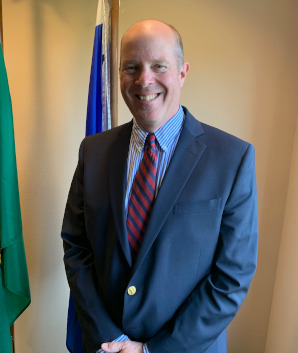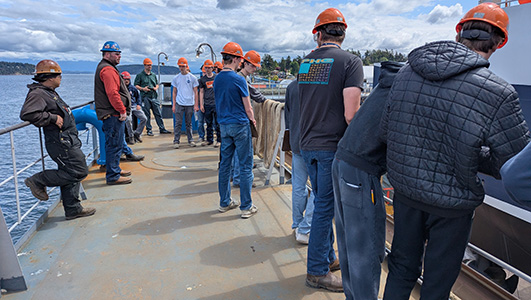||| BY MATTHEW GILBERT, theORCASONIAN REPORTER |||
First, a lengthy preamble for context.
In “How Climate Migration Will Reshape America,” journalist Abrahm Lustgarten, looking at the not-too-distant future, writes that “The millions of people moving north will mostly head to the cities of the Northeast and Northwest, which will see their populations grow by roughly 10 percent, according to one model.” I have personally heard from three friends in fire-ravaged California who have set their sights on the Northwest. Anecdotally, this summer saw more owner-occupants of “second homes” who decided to stay longer – some of whom are planning to make them a primary residence. The pandemic was the spark, but it’s one of many, and a changing climate could be added to the list.
Climate change (and its impacts) was not added as a separate element in the 2016-2036 San Juan County Comprehensive Plan – still being written – despite strong public interest when the update was launched in 2018. The county instead decided to address those impacts in the various elements that already exist – Housing, Land Use, Transportation, Water Resources, Economic Development – though it’s difficult to determine what those enhancements are. A paragraph on climate change was added to the Comp Plan Vision Statement:
Our community sets an example with its response to climate change. We prepare to address the negative effects in advance before they become crises. Our community encourages voluntary efforts and enacts incentives and regulations if necessary to reduce our carbon footprint.
Sifting the Data
This year’s pandemic certainly chilled tourism traffic (system-wide ferry ridership over Labor Day was 35% below normal, roughly approximating a reduced schedule), but the underlying conditions that make these islands appealing haven’t changed. They suggest that additional thought be given to whether the county has the right tools and vision to anticipate and manage what could be an acceleration in both visitors and permanent residents on top of current trends.
To wit:
- There has been a steady uptick in county residential building permits over the last five years, from 88 to 100+.
- Despite the pandemic, real estate sales in San Juan County in the first half of 2020 were comparable to 2019 – up slightly in transactions, down slightly in dollar volume. On Orcas, there was a 10% increase in transactions and a 19% decrease in volume. Multiple offers were not uncommon. Meanwhile, the rental market has essentially dried up. Applications for the new OPAL project were double the available vacancies.
- The county’s 2020 Change of Value Notices, based on sales between January 1, 2019 and April 30, 2020, reports that, “The total assessed value for San Juan County increased more than $200 Million over last year, including $110 Million in new construction value.”
- According to Housing Program Coordinator Ryan Page, 37% of the county’s 14,030 housing units are categorized as “For Seasonal, recreational, or occasional use” (second homes) – most of them empty.
- Ferry traffic to the islands has increased approximately 15% since 2011 to 950,000 vehicles and 2 million riders, with vehicle growth outpacing rider growth. There is no reason to assume that trend won’t continue once the pandemic is
behind us. - While this year’s number of new vacation rental permits is uncharacteristically low, the trend has been upward. A cap on vacation rentals (VRs) is under discussion in the Comp Plan update, but until something is enacted, more VRs will keep adding to visitor impacts.
- There are approximately 5,000 developable lots in the rural areas of the county. Given that most new folks moving to the islands end up outside existing activity centers, preserving rural character will become more challenging.
- Yearly population growth since 2000 has been under 1.0% – below projections. But as more second homes become first homes, and with a steady increase in building permits, that rate may go up. An increase in the population would also mean more visitor traffic.
All of this puts increasing pressure on: the county’s physical infrastructure, its ability to provide necessary services (e.g., water, medical, housing, transportation), progress on reducing our carbon footprint, and the integrity of our natural spaces and rural character. The Comp Plan update is attempting to accommodate those needs into 2036 based on a projected growth rate of 1.0%, but what if the actual number is quite a bit higher?
This pandemic year notwithstanding, a fundamental tension remains between preserving “quality of life,” meeting community needs, and sustaining economic viability that could be squeezed even more by climate impacts.
Against this background, we asked the County Council candidates for District 2 the following three-part question:
If “climate change/migration,” along with existing trends, drives unexpected growth in population and visitor traffic:
- Should the county keep expanding its services and infrastructure to meet those needs or develop new ways to manage that growth?
- Is the county sufficiently equipped with the tools and understanding to know how many people the islands can “comfortably” accommodate?
- Where is the county most vulnerable (e.g., water availability, medical services, housing) and what, specifically, would you do to address it?
Cindy Wolf responds:

If all of our 5,190 seasonal homes were to become primary homes for two people (and none of our 5,000 developable parcels get developed), we would experience a population increase equivalent to the current population of San Juan Island. The attendant burden on our infrastructure will be enormous. We will require more housing for trades people and service workers, more water supply, more ferry service, more demand for health care, more energy demand, and so on. The county does not have a plan to address this. The county Comprehensive Plan will not suffice.
Cities and counties often control growth through permitting, issuing only as many building permits per year as they project they can cope with in terms of infrastructure improvements. If very little of our current housing stock converts to year- round, this method of control might work. The problem is that it tends to drive up real estate prices, and we’d be imposing limits on the industry responsible for 19% of gross profits and 18% of earnings in the county economy (per the EDC website).
Slowing growth to a manageable pace means we must create livelihoods that do not depend on new housing construction or tourism. Defining an appropriate rate of growth requires some data we simply do not have. Funding for our proposed water survey fell victim to the governor’s COVID-related budget cuts, so we have no idea what our total freshwater resource is and how quickly we are already losing it to saltwater intrusion and aquifer depletion. We also need to know how much excess capacity we have in our utilities. Eastsound Water and Sewer is already in need of a third treatment tank and, ideally, would like a fourth so the first two can undergo maintenance. How much acceleration are we seeing in year-round home purchases? In the face of intense market pressure, we need to make land and housing available to young
workers.
We need a much better understanding our current situation so we can develop a plan based on the changes and tradeoffs we are willing to make. Are we all willing to use less water to make room for more people? Are we willing to pay higher ferry fares in order to build more boats or compete with more people for the same number of reservation spots? Developing and implementing goals based in reality will make for a better outcome than guesswork and nostalgia.
Rick Hughes responds:
 San Juan County is certainly equipped to understand future populations in our islands. We’ve had this conversation for many years and have been planning accordingly. Twenty years ago, even, the county committed to expanding roads to include four-foot shoulders between major points of interest. Comprehensive trails networks have been on the list for just as long. We’re just now getting around to some of these things, but we’re getting them done. LTE Wireless; affordable housing; expanding our emergency response network; the dog park; the Exchange – are all recent improvements made in our community. In planning and executing these, there was never a feeling that we needed to keep up with growth or attract visitors. Ultimately, it’s been about – and should continue to be about – identifying what our community needs and doing our best to fill that need. That is the role of government.
San Juan County is certainly equipped to understand future populations in our islands. We’ve had this conversation for many years and have been planning accordingly. Twenty years ago, even, the county committed to expanding roads to include four-foot shoulders between major points of interest. Comprehensive trails networks have been on the list for just as long. We’re just now getting around to some of these things, but we’re getting them done. LTE Wireless; affordable housing; expanding our emergency response network; the dog park; the Exchange – are all recent improvements made in our community. In planning and executing these, there was never a feeling that we needed to keep up with growth or attract visitors. Ultimately, it’s been about – and should continue to be about – identifying what our community needs and doing our best to fill that need. That is the role of government.
And beyond infrastructure, we have other issues to tackle: Senior care, medical care, and a reliable ferry system are just a few. I feel affordable housing is likely our biggest challenge. With some homes lost to the vacation rental inventory – and even more to new home purchases by both year-round and part-time residents – our teachers, nurses, police officers, and tradespeople are struggling to find secure housing. A community clearly cannot thrive if its lifeblood is struggling. This is why the county has committed almost $4M to developing affordable housing and why I am committed to making sure this – and our other challenges – are met one way or another.
But it won’t be easy. The recent – and likely lingering – effects of Covid-19 on our economy are straining our budget and our ability to provide even our core services. In order to maintain a sustainable model of service to our community, we will need to do more than just identify needs and deliver services. We will need to be judicious and forward thinking. We’ll need to make tough decisions and look outside of the box for solutions to situations we’ve never seen before. My working relationships with government leaders and my experience budgeting on both the county and business level has proven extremely valuable thus far. If we can borrow on the forward thinking that has brought us to this point, I’m confident we will find our way through so that we can continue to increase the quality of life for everyone in our county.
**If you are reading theOrcasonian for free, thank your fellow islanders. If you would like to support theOrcasonian CLICK HERE to set your modestly-priced, voluntary subscription. Otherwise, no worries; we’re happy to share with you.**








Climate change is a game-changer for sure. And though SJC is still only thinking about thinking about doing something Rick has said that if re-elected he will be our climate change champion. My heart goes out to homeless refugees everywhere. Whether they’re the collateral damage from a war-ravaged area, or part of the new climate change reality they are the end result of corporate interests. Your article is an eye-opener Mathew, and causes me to think about what is, or what can our role be as a community in helping others who have lost their homes? How I wish there was a way to adopt needy people (truly needy people) at a time like this, and create a win-win for everybody.
“With some homes lost to the vacation rental inventory – and even more to new home purchases by both year-round and part-time residents – our teachers, nurses, police officers, and tradespeople are struggling to find secure housing.”
I find no small irony in the fact that at the same time that you’re able to admit this… that your response to the vacation rental working group outlines a growth scenario for vacation rentals with a cap nearly four times more than what we have now. It’s never to late to have a “serious” discussion regarding vacation rentals and over-tourism… now is as good a time as any.
Ok, it’s time for the county to address this problem; there needs to be a priority loading pass for island residents.
Has anybody else have trouble scheduling a doctor appointment off-island?
Yes.
I frankly don’t care that tourists spend money for four days up here.
My family and friends spend money every day on Orcas. At the Market, the gas pumps, the restaurants (take out for now), and propane, car mechanics, you name it.
It makes sense to provide full-time residents with proper ferry service, since we are actually carrying this community.
This could be done with simple ID or a special island transit card and reservations.
The tourists can wait.
Yes, I’m sick and tired of having to wait an extra hour or more in the ferry lines because of long delays this summer. Island residents should be able to show up a half hour before the ferry departs— not before the scheduled departure—and still get on the boat.
So is it preferable to have the 2nd home owners become full-timers and get the benefits of their tax dollars, or is it better to keep them renting their homes for a few months/year or just vacationing now and then and thus not need all the year-round services and strains on the infrastructure? Growth of a community just like cancer still needs a “blood supply.” For SJI it’s the ferry. Limiting the ferry is still the easiest way to control growth.
Spot check: Looks like Cindy did some arithmetic from the preamble. Points!
Few of the “seasonal” homes are “empty.” That’s really a silly way to look at them. People use them in the summer and on holidays and many retire to them.
As for infrastructure costs, the “seasonal” homeowners pay full taxes, as if they live there year-round. That is a benefit to us full-time residents.
The fact is that every parcel on the island is owned by someone. The County cannot deny building permits for people who own parcels if their plans comply with the code, unless I’m wrong.
It would be great to get the Prosecuting Attorney staff involved to delineate what can and cannot be done under the Constitution and statutes of the state. We keep spinning our wheels without progress, and not knowing what tools are available is a real handicap.
Inspired by Peg: I know what doesn’t help–political ideologies, rather than principles of cooperative government; squeaky wheels, rather than equal treatment of the governed.
It gets messy.
It would seem easy to prioritize island residents for making ferry reservations. The DOT has HOV lanes that restricts usage for qualifying users and on 405 those that can afford it get to use selected HOV lanes even though taxpayers pay for the roadways. The Ferry System already restricts usage by a reservation system. Please, let’s have a fair reservation system that gives full time residents some priority.
I’m bringing Symons back.
Paige–I’m puzzled by your comment. I don’t see political ideologies here, and squeaky wheels result from a decade or more of discussion going nowhere. We need to focus on what the facts are and what the law is to inform decisions about what actions to take to address the concerns we all have. I’m not sure what “principles of cooperative government” means but equal treatment of the governed is certainly one part of the puzzle.
Does anyone have the cite for the court decision or law that prohibits priority for residents on ferries ? Couldn’t find it.
Imagine if Seattle, Tacoma, Bellingham or mountain pass area residents said they deserve preferential usage of “their” highways because of the inconvenience of traffic caused by non-residents. That’s what I see being proposed in these comments.
Peg,
From what I have been told and in my own research of the matter, the issue is not set in a legal precedent. Now… I’m not a lawyer, but I believe it is buried somewhere in the state tax code, which requires equal application and access of services provided by state tax dollars. If I can find it I will. Again… not a lawyer, so it could be a long digging expedition!
With that said, I have floated the question of inputting a concept of a “good-to-go” type system in place that, I believe, would offer an alternative that may help locals. As it would have to pass multiple approval processes, require a full reconfiguration of the reservations and payment system and clear the fare committee as well as the legislature…. it’s a long-shot. Clearly, ferries are a major concern in this upcoming budget cycle, as the governor has mandated what is essentially a 10% across the board cut in budget proposals. As a county, we need to our leadership to continue to be active In Olympia. We are lucky in that Rick has been in Olympia making noise in our behalf and continues to battle for us. He is the only local official from in the state who is regularly in the chair in front of the transportation committee keeping us relevant. I fear that if we lose his voice, we will pretty quickly see our service cut even further.
Hi, Peg. That’s okay. We can parse some other time. Thank you. No offense, none taken.
Justin, I like the idea of the good-to-go system, but does that work well/fairly for people with lesser means?
Ed,
Probably at the top of my obstacles list is “equity” as it relates to a proposal such as this. We would need to look at all mechanisms currently available to resolve that issue that are both legal and appropriate.
This is a concept in its infancy and we would need to make sure that we don’t end up with unintended consequences which might be worse than the problem we are trying to solve.
Justin–I AM a lawyer, and pretty good at searching, which I why I was so frustrated being unable to find it. But you might be on to something, and I’m ready. We have to bite the bullet and book some medical appointments in Seattle. That requires finding ferry reservations and physician appointments that match up, preferably on the same day so we don’t have to stay overnight. It used to be a fun challenge to do this. Now, I’m worn out.
Peg-
I have sent off a request for research on the rules/laws that apply to this situation. I expect it will take a few weeks for my request to filter through the system, but will definitely post what I get back.
This may not be read, as it’s now 2 days after the article, but here goes:
Re: ferries. The ferry structure is a State run entity to which our County governors and the Ferry Advisory Comm can only make recommendations, and relay. our grievences, and put pressure on.
I volunteered as a rep from Orcas to be on the Reservation Partnership Committee when WSF was working to give us a workable reservaion system (if you lived here pre-reservations time, you know how badly it was needed). They presented their plans, we commented, and many times we were influential in suggesting different options. It was in those meetings we were told, as Justin says that, being a state entity, the ferries were bound to “equal application and access of service”, and any priority system would not be a go. Thus the 3 tier reservation system was born (the idea of a Lopez volunteer). It serves residents almost as well as a priority system, as we are the ones that mostly reserve within the last 2 weeks or 2 days of sailing, and know to get up by 7:00a.m. to reserve one of the last 30% of vehicle spaces. It’s not perfect..nothing could be. But I, personnally have never had the system fail with my many recent off-island trips. If you’re wondering, ask WSF.
Peg,
I have faced that recently and If you get a form signed by your doctor you’ll get on your ferry. You have to call the ferry system
and ask them to fax or email the form to your doctor. Happy Trails.